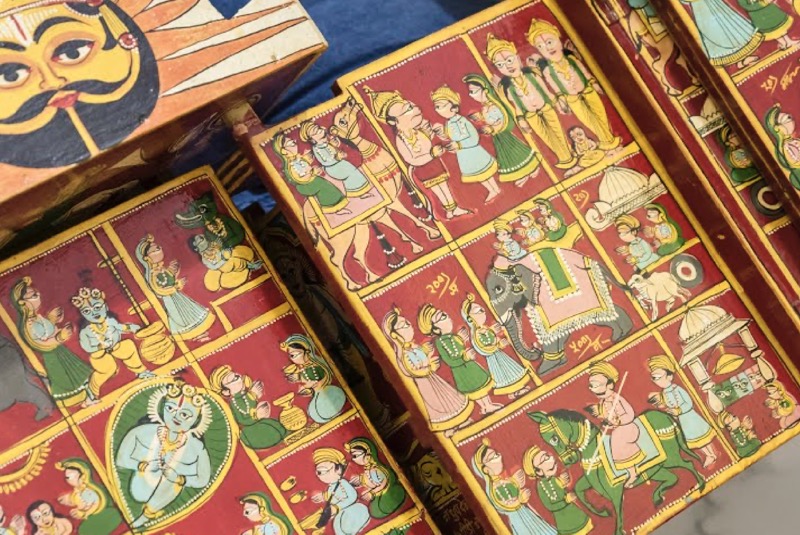The art of visual storytelling in India goes back to ancient times. Caves carved with pictures depict legends of local gods and goddesses, narrate tales of the kingdoms and empires, serve as significant archaeological sources in mapping history. Visual storytelling also plays an important role in preserving the folk traditions of our country, putting the rich cultural heritage of our country on display.
One such vibrant art of storytelling emerged in Rajasthan over 400 years ago, the art of Kavad. If you have had a chance to see a Kavad before, you know that it is whole another world inside a box. But if you have not, it is not surprising, because they are getting rarer by the day.
A Kavad is a brilliant wooden box painted with vibrant colours. It has hinged panels that open to reveal beautiful handpainted pictures of the classic stories and narratives of Gods, Goddesses, local heroes, saints, patrons, and rulers. Kavad is a portable shrine that may measure between 3 to 12 inches in size for people who cannot access temples for any reason and comprise 12 to 16 hinged panels.
The origin story of Kavad connects to the legend of Shravan Kumar and King Dashrath, father of the venerated Hindu Lord Ram. Shravan, popularly mentioned in Ramayana, is known for his devotion towards his parents. Dashrath accidentally killed him with his arrow while on a hunting trip in the forest of Ayodhya.
Shravan’s parents were blind. Shravan carried them in baskets tied on both ends of the pole, also known as “kaawadi”, hoping to take them to sacred places of pilgrimage. As Shravan died in front of Dashrath, he made his dying wish. He asked the king to bring the shrine to his parents. While there are many variations of Shravan’s dying wishes, locals believe that the concept of a portable shrine, the Kavad originated here.
An artisan caste of Rajasthan, namely Kumawats is credited with initiating the tradition of making Kavad in the hamlet of Bassi in Rajasthan. The carpenter community of Suthar and Jangid (Jangid Brahmins) practice the art to this day. They often use the same title as their last name to signify the profession. The Jangid community claims to be offsprings of Lord Visvakarma, revered as the “architect” of the universe and God of the arts.
Making a Kavad is not simple carpentry. It is a work of art. The artists use wood from mango and semla trees to make the structure with simple tools, such as saws, drills, and hinges. After each part of the box is crafted, the painting process begins. Initially, the painting of myriad pictures used natural dyes. Now, since mineral colours are readily available in the market, Kavad artists utilise them instead.
Mineral colours are in powdered form. The artist blends the powder with a resin solution for adhesion. Women of the community are actively involved in this process.
Rajasthan’s vibrant culture lies at the heart of the traditional art of India. One always imagines the bright shades of red, green, yellow, and blue thinking of Rajasthani art. A look at Kavad leaves no doubt that it emerged with the traditions of Rajasthanis.
The original art of Kavad used red as their primary colour for the base. However, other colours gained popularity with time, and artists did not shy away from making them available. After preparing the mineral paint, each piece of the wood is pained with the base colour, followed by outlines of the figures using a fine brush. Bright colours of the Kavad pallet comprise yellow, white, red, blue, green, and black, used to paint the characters. Buyers may choose customised boxes with modern colour schemes and pictures, giving Kavad a fresh new appearance.
After completing the painting process, each piece is assembled to make a finished kavad using metal hinges and wooden pivots.
Traditionally, a storyteller, kavadiya bhatt, carried Kavad and wandered house to house to gather a crowd of listeners. As a kavadiya bhatt opens each fold of the kavad, he entraps the audience into an engaging story.
People are less likely to stop and listen to kavadiya bhatts now, so these picturesque boxes are sold as decor items. The end goal of Kavad used to be the narrative; hence, the painting technique and character delineation were not necessarily etched for its beauty. But with Kavads gaining recognition as works of art, the painters place greater care into the quality of the lines and colour.
The art of making Kavad is degenerating as the community slowly abandons the traditions of storytelling. There is a shift of intention from preserving the tradition to protecting their livelihood. Only a few artists in Rajasthan and Banglore survive the art by adapting to market demands.
Kavad painters have taken up painting temples in private residences and maintained their distinctive style of paintings. With shifting lives and cultural traditions, many professionals have moved into different fields. The artisans adapt to new opportunities in a changing environment by combining their carpentry and painting talents; however, it risks the loss of Kavad art into oblivion.
Copyright©Madras Courier, All Rights Reserved. You may share using our article tools. Please don't cut articles from madrascourier.com and redistribute by email, post to the web, mobile phone or social media.Please send in your feed back and comments to [email protected]











